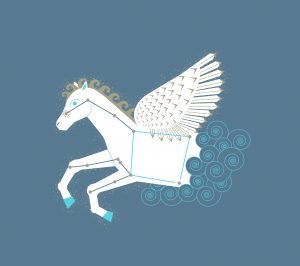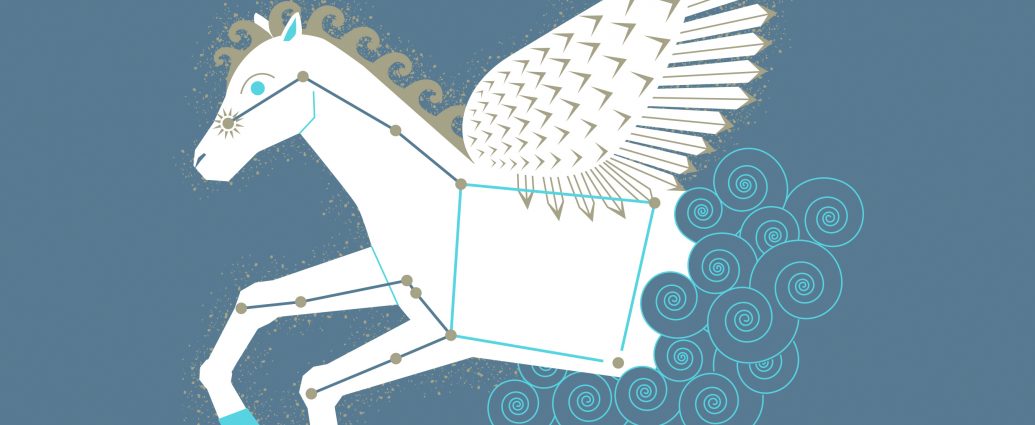The clocks have gone back, the nights are longer and oh baby it’s cold outside, but if you wrap up in your winter woollies and venture outside, you will discover nature’s most illuminating and spectacular free show in the sky up above…
Imagine the dark night sky in the countryside, far away from street lamps and car headlights. Gazing upwards, the sky is bright with the glow of stars, some shining brighter than others, or clustered together in interesting shapes and patterns. Watching the stars these patterns begin to look familiar… but what could they be?
 Andromeda
Andromeda
Andromeda’s brightest star is part of an asterism called the great Square of Pegasus.
Andromeda was a princess known for her kindness and beauty. One day her proud mother, Queen Cassiopeia, boasted that her daughter was more beautiful than the nereids, the famously beautiful sea-nymphs. This made the Nereids so angry and jealous that they asked Poseidon, god of the sea, to punish the family. A vicious sea monster, Cetus, was sent by Poseidon to terrorize the nearby coast. Andromeda’s father, King Cepheus, was told that the only way to stop Cetus was to offer the terrible creature his wonderful, innocent daughter. Andromeda was chained to a rock as a sacrifice, but just before the sea monster gobbled her up, a kind hero, Perseus, killed the monster and unchained Andromeda. Then the two rode away on the winged horse, Pegasus.
 Cassiopeia
Cassiopeia
An important constellation that is small but bright, with a shape that’s easy to remember. It is shaped like an M or W, depending on the time of year.
Cassiopeia was a queen of Ethiopia who cared a lot about looks, and spent a
lot of time thinking (and bragging!) about her beauty and that of her daughter, Andromeda. She is often pictured sitting on her royal throne, looking at herself in a mirror, and brushing or smoothing her long hair. Cassiopeia’s bragging almost cost the life of her daughter, and her story was a reminder to the ancient Greeks that it is better to put energy into kindness than beauty and looks.
 Orion
Orion
One of the best-known constellations in the sky and easy to find because it has some of the brightest and most distinctive stars in the sky. Orion contains two very well-known asterisms: Orion’s Belt and Orion’s Sword.
Orion, the son of the sea god Poseidon, was a hunter who was unusually tall, handsome and strong. One day Orion went hunting with Artemis, goddess of the hunt, and bragged about how he could kill every animal on Earth if he wanted to. This made Gaia, the earth goddess, so angry that she sent a giant scorpion, Scorpius, to kill him. Both Orion and the scorpion were placed among the constellations as a warning to others not to upset Gaia. Orion has his trusted hunting dogs, Canis Major and Canis Minor, behind him in the sky to help and protect him.
 Pegasus
Pegasus
One of the largest constellations in the sky, whose brightest stars, when combined with one of the stars from its neighbouring constellation, Andromeda, form a square shape that is an asterism called the Great Square of Pegasus.
Pegasus was a winged horse that is said to have been the child of a surprising combination of parents: Poseidon, god of the sea, and Medusa, a winged monster with snakes for hair. Wherever Pegasus’s hooves touched the ground, water would magically spring up. Pegasus is best known for helping great heroes such as Perseus, who rescued the princess Andromeda, and Bellerophon, who killed the fire-breathing, three-headed monster Chimera. Later, Pegasus lived in the gods’ stables on Mount Olympus and delivered thunderbolts for Zeus.
An edited excerpt from Seeing Stars: A Complete Guide to the 88 Constellations by Sara Gillingham.
Star Fact File
- A constellation is a group of bright stars that forms a picture when imaginary lines are drawn between them. Like playing connect-the-dots in the sky.
- Scientists who study the stars are called astronomers and constellations help them find their way around the sky.
- Telescopes were invented 500 years ago and helped astronomers see much more of the sky than ever before.
- In 1922, a group of astronomers from around the world (known as the International Astronomical Union) felt it was time to make an official map of the sky for all astronomers and decided on 88 official constellations.
- The best kind of night for viewing stars is when the sky is clear and the Moon is new, or at least not full.
- Did you know? The sun is also a star!
The perfect place for seeing stars in Scotland? Galloway Forest Park in Dumfries and Galloway is one of only four “Dark Sky Parks” in the entire western world and the only one in the UK.

Sara Gillingham is an award-winning art director and designer. She was the Design Director for Children’s Publishing at Chronicle Books and taught at UC Berkeley and California College of the Arts. Seeing Stars: A Complete Guide to the 88 Constellationsby Sara Gillingham is published by Phaidon HB £17.99 Ages 7+.

